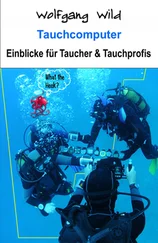Dive Tables – the STUP effect
A former both popular and trivial comparison of dive tables looked like this:
Take several dive tables, note their no-decompression limits in a graph – and without further ado the table with the shortest no-decompression times for certain depths was entitled to be the “safest” table, because this one obviously was the “most conservative”.
The following tables for air just serve as examples; the first three of them are dive tables which are or used to be popular in German speaking Europe.
Notes: “VDST” means “Verband Deutscher Sporttaucher”, which is the German CMAS federation branch; University Zurich [correctly spelled Zuerich with u-umlaut] refers to the hyperbaric chamber in the capital of Switzerland that Albert Buhlmann [correctly spelled Buehlmann with u-umlaut] used for developing his famous ZH-L algorithm which is discussed later in this eBook.
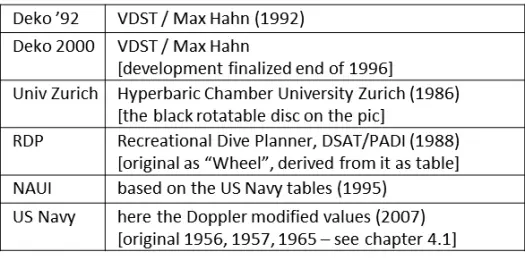
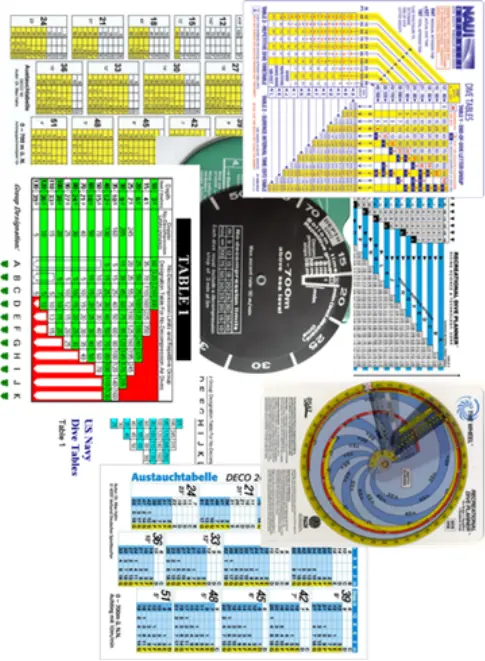
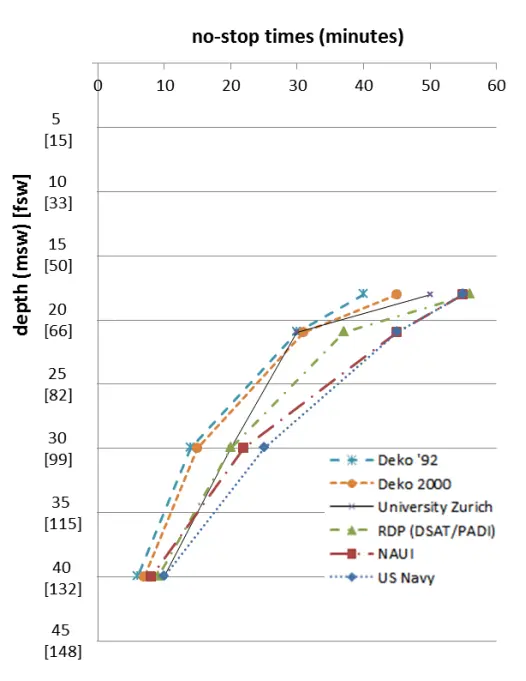
[Note for eBook readers with a device which cannot display colors: The upper broken line depicts the Deko '92 table, the lower dotted line shows the US Navy tables.]
The graph shows us the dive table with the most conservative values – correct?
Not really. There is another dive table with significantly shorter no-decompression times and no-decompression limits:
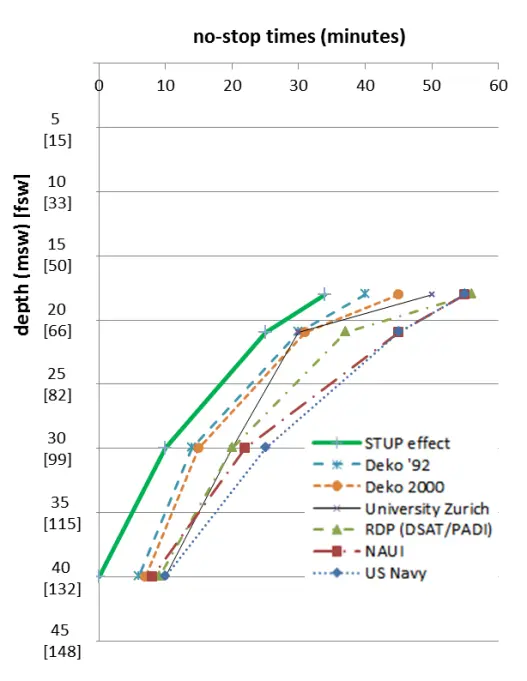
[Note for eBook readers with a device which cannot display colors: The upper unbroken line (green) shows the STUP effect.]
The reader will ask himself with good reason: From which dive table does this green line originate? Well, honestly spoken, from no dive table available on the market. But this table can be “produced” easily and quickly: Just take a pen, place above the former most “conservative” line some points and connect these. And – lo and behold – you have generated a safer because more conservative “dive table”. (Using EXCEL this is a matter of seconds ...)
Question: Is there perhaps even an enhancement of this awfully economic developing procedure?
Answer: Yes. The STUP principle – Stay Up. Because for divers it is of course safest not to go diving, staying at the surface or even better at home instead; this has the advantage of sparing all the grappling with dive equipment and avoiding the uncertainty of potentially being hit by decompression sickness (DCS).
Note: Actually even at home you can not be sure not to get hit by DCS. Raymond Rogers has pointed to that chance when criticizing a popular mathematical equation used by many decompression scientists that time; Rogers concluded that if this equation was valid an unlimited no-decompression limit could only be found to be “a fraction of a foot deep”:
“This would imply that if you lay in your half-filled bathtub long enough, you’d get decompression sickness when you stood up!”
Source: Rogers, Raymond, Renovating Haldane, The Undersea Journal, Third Quarter 1988, p. 17
The reader and enthusiastic diver will understand how this hint by Rogers is meant (animated, winking smileys unfortunately don’t show well in eBooks …). And smiling while reading this eBook is explicitly allowed.
So, this approach is of course not the way to seriously discuss the topic “conservative” no-decompression times.
If we really want to be able to test the “performance” of a dive table (or of a dive computer) and compare it with other dive tables (or dive computers) then we’d need to know from the developer (or more modern: from the designer) of the dive table resp. dive computer in which way the concept or design had been created. Which parameters (besides depth resp. pressure, and time) found their way into the design – and, above all: How has been validated whether a diver using it will come back home from his dives safely and healthily – i.e. without being hit by DCS (very likely not being hit, at least).
Unfortunately there is an inglorious “tradition” among the designers which perpetuated from dive tables to dive computers: Only with few exceptions the diver receives answers on such questioning – usually he doesn’t hear anything (or nothing specific).
What is the common language regime in advertising, promotion, and instruction manuals? ”Modified Haldanean model”, “US Navy values, adapted for recreational divers”, “Buhlmann ZH-L16 with gradient factors”, “based on RGBM”, etc.
It can be that a diver who respects the no-decompression limits of a certain dive table or dive computer will surface without any problems, and will continue diving after some surface interval, safely and healthy. But it can also be that this diver could have been even longer under water for some time.
Briefly speaking: Perhaps the diver has shed wonderful time under water with this dive table or dive computer, because he surfaced too early and therefore did not see the Whale Shark, Nautilus or any other creatures of our dreams. And in this case he’d also have shed valuable breathing gas because usually tank fills cost money.
Note:
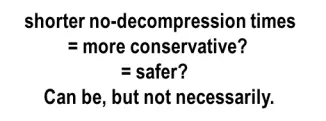
Let us finally check how the dive tables which we have used above differ when strained for a repetitive dive:
To properly do that (divers who were trained to handle dive tables know this) we need the so-called pressure group (PG) which represents the residual nitrogen from the previous dive, and we need of course the duration of the pause at the surface, the so-called surface interval (SI). For our example let’s assume that we want to return after a surface interval of one hour again to the same depth of the first dive, which was 18 meters/60 feet (in the hope to revisit the curious-playful Octopus there). How long could we stay there for another no-stop dive? For dive number one let’s assume a dive time of 50 minutes:
• Dive #1 – depth: 18 m/60 ft, time: 50 minutes
• SI – 60 minutes
• Dive #2 – depth: 18 m/60 ft, time: maximum no-stop time
Above dive tables would allow the following no-stop limits for the second dive to 18 m/60 ft:
• 6 minutes – Deko 2000 and US Navy (2007)
• 10 minutes – Deko '92
• 24 minutes – NAUI (1995)
• 34 minutes – Hyperbaric Chamber University Zurich (1986) and RDP/DSAT (1988)
What does that mean? Do these results mean that the tables allowing only 6 minutes are several 100% “safer” than the others, and the extensively validated DSAT table with its 34 minutes should be regarded as “unsafe”, then? Think of the following: Grammatically a comparison of the adjective “safe” is possible (safe – safer – safest), but content-wise this does not make any sense. Either safe – or not. And as we have learned before: only STUP is safe, somewhat at least. So the answer to above question is as before: Can be, but not necessarily. And, being honest: Who of us would really assemble all our equipment for just another 6 minutes under water? Alternatively, the flexible diver could have switched to a different table from the very beginning …
Читать дальше








